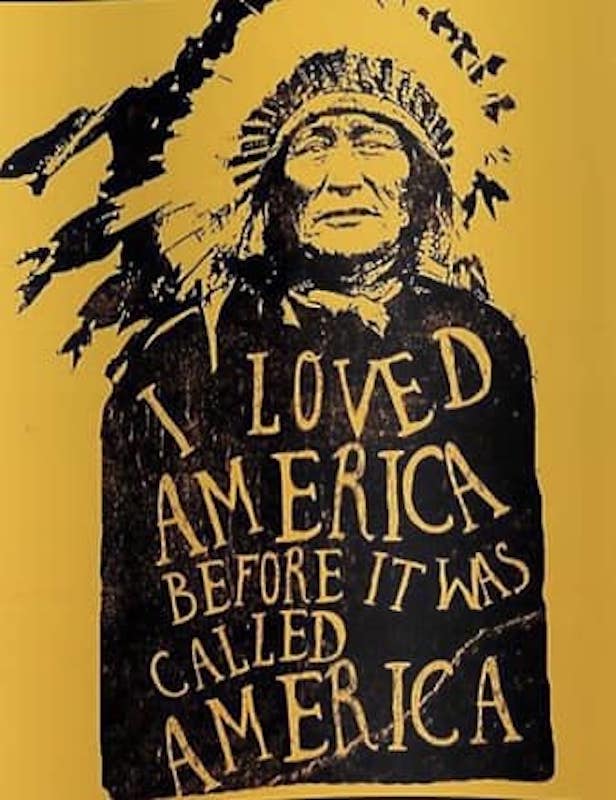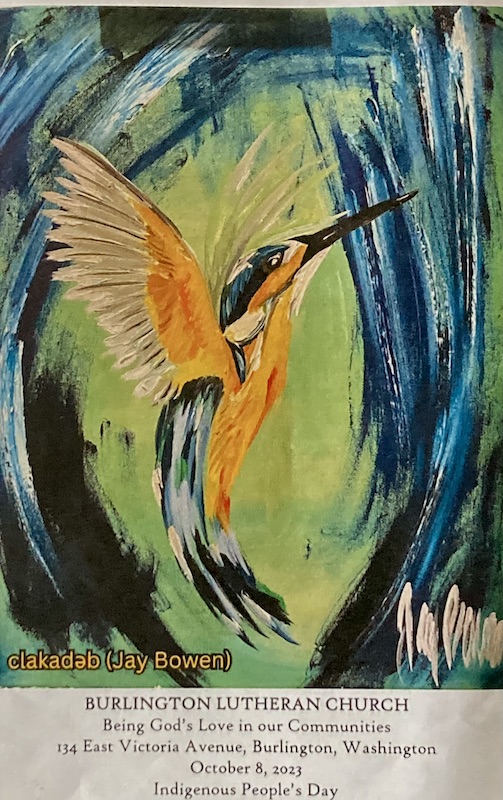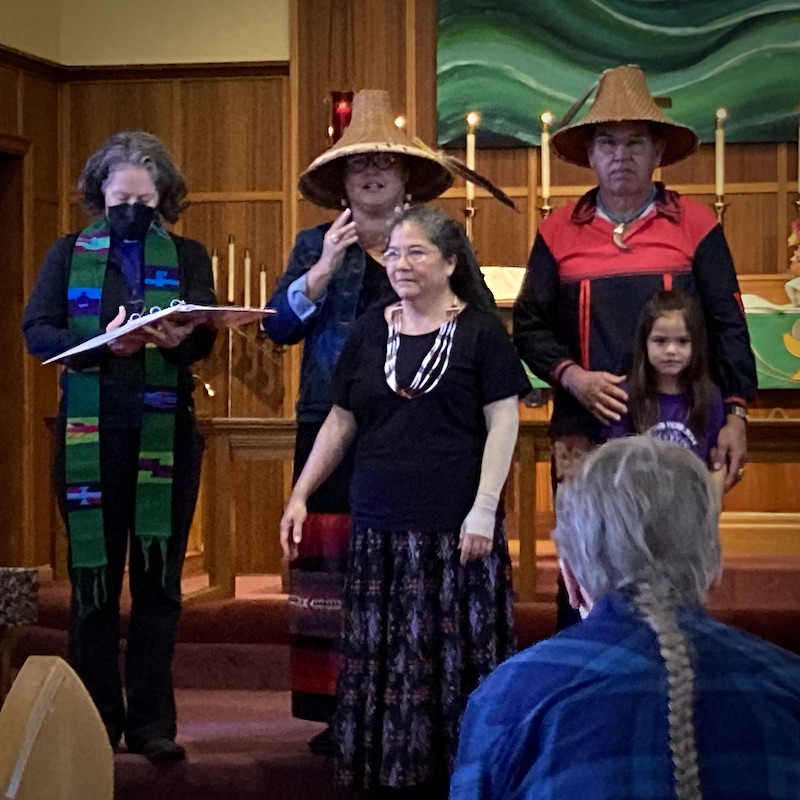Tales of the Magic Skagit: Happy Indigenous People’s Day, Christopher Columbus!

“Are you blind to the Sacred Teachings?” He said to them. “Have you not read this: ‘the tree the lodge builders threw away has become the Chief Lodgepole. This is what the Great spirit has done, and it will fill us with wonder’.” — Matthew 23 (First Nations Version)
As a kid, the most significant thing about Columbus Day was the fact that it was the first respite from school following Labor Day and the official end of Summer Vacation. It was also first in line in the seasonal procession to Christmas. In just a few weeks after Columbus Day, my friends and I would be filling plastic pails with Halloween loot — the last of which (if we rationed it well) might be consumed while we watched the annual Thanksgiving Day Parade, live from New York City.
You had to get up plenty early to catch the Macy’s Day Parade if you lived in San Francisco, but you could be pretty sure that your mom would be up as well, and that before long you’d be inhaling the heady aromas of roasting turkey, oyster stuffing, and pumpkin pie while contemplating the joys of the coming Yuletide…the crowning glory of the kid calendar.
But if you grew up in San Francisco, there was an added significance to Columbus Day beyond the recognition that in 1492 a Genoese seafarer sailed the ocean blue on behalf of European monarchs who financed the expedition with wealth they had confiscated from the recently expelled Moorish population of Spain. In San Francisco, my City by the Bay, Columbus Day was pretty much “Italian Pride Day.”
I was perhaps more keenly aware of this than some of my other grade school classmates. After all, my Aunt Sue (who was like a second mother to me) had abandoned the Protestant faith of her Midwestern ancestors and married an Italian Catholic, my Uncle Vince Baldetta. There was actually a time in my childhood when I fervently believed Jesus was Italian, thanks to a popular portrait gracing the walls of many an Italian-American household in which our Lord and Savior’s olive hued profile rendered him a true paisano.

Of course, Christopher Columbus remains at the heart of the American origin story — at least if you studied elementary school history — which seemed very odd to me once I realized that Columbus never actually set foot on the soil of the political entity we now know as the United States of America. If the significance of Columbus Day as an American holiday is to acknowledge the contributions of Italian Americans (I can remember when the Bank of America was the Bank of Italy), I’m totally down with it. As a holiday meant to commemorate the “discovery” of America, however, it just makes more historical sense to me to acknowledge the people who actually discovered it first, back before the ancient Egyptians had even drawn a schematic for the first pyramids.
If we as Americans truly want to tell our origin story, why set the marker at the late 15th century when what we’re really talking about here is time out of mind? With that very question in mind, my wife and I decided to celebrate Indigenous People’s Day 2023 by attending a worship service on Sunday, October 8 at Burlington Lutheran Church. Indigenous People’s Day Worship was a collaboration of the church’s clergy, congregation, and several elders of the Upper Skagit Tribe, upon whose ancestral land the church rests (along with the rest of the Skagit Valley that wasn’t originally under the care and stewardship of the Swinomish). By the way, I’ve often thought that it must have been pretty easy for the first white Christian missionaries to convey the concept of the Garden of Eden to a people who had been inhabiting it since “time immemorial.”

On its Facebook page, Burlington Lutheran Church offered the following description of its October 8 service: “In honor and recognition of Indigenous People’s Day, and to continue our journey of building relationship with our Skagit neighbors, we couldn’t be more thrilled that clakadəb (Jay Bowen), skʷalx̌ax̌alic̓əʔ (Kay Knott), and tsi sq́ʷalʔalq́ʷal (Lora Pennington) will be our worship leaders this Sunday. They will bring Lushootseed prayers, a profound message, and laughter. Burlington Lutheran is incredibly fortunate to hold friendship with these three Upper Skagit Elders; this service will be meaningful, moving, and motivating.”
While my wife and I found the service to have indeed been meaningful, moving, and motivating from beginning to end (you can view it in its entirety by going to Burlington Lutheran’s Facebook page for October 8), there were a number of moments that especially resonated with me given my past decade of getting to know the history of the Magic Skagit. I’d like to share those with you.
Following the opening procession with Pastor Charis Weathers and the visiting tribal elders, a member of the congregation who had lived among the Cree Tribe recited a greeting in their language. Kay Knott then offered a welcoming blessing in Lushootseed that was originally presented by Vi Hilbert as a “thank you” at gatherings. You may recall my earlier podcasts and stories about Vi Hilbert, a member of the Upper Skagit Tribe who made preserving the Lushootseed language her life’s work. Translated into English, in which Vi was equally fluent, the blessing reads:
To all of you my (dear/honorable/beloved) people. We give thanks to you, we thank you. It is good that we can gather on this day/evening. We pray and we humble ourselves to our spirit/our Creator, my dear people. We give thanks that all of you are here with us. We help each other. We help each other in this way. We strengthen one another!

Following a Children’s Message, during which Jay Bowen (clakadəb) reminded the little ones from the congregation who gathered around him of their unique gifts (giving them each a present of art supplies with which to express that uniqueness), there was a reading from a poem by Father Patrick Twohy, a Jesuit priest who lived with and served the Native Peoples of the Pacific Northwest for decades, including the Swinomish and Tulalip Tribes. The poem, “Before the New Beings Came,” was from his writings entitled, “Beginnings: A Meditation on Coast Salish Lifeways.”
Before the New Beings Came
Before these new beings came,
The people lived all along the rivers
And on the best beaches of the wide bays
That faced out to the neighboring islands guarding
Pathways to the deeper waters of the sea.
The people were gentle and generous
To visiting family and friends.
Large families lived in long homes
Framed with cedar posts and beams, roofed and walled
With cedar planks split with elk horn and yew wood wedges
From the north side of the tall trees that joined
The powers of sky and earth for as far as even the eagle could see.
Cedar, strong and lasting;
Cedar roots stripped for the fibers to weave baskets,
Round, tight, beautiful to the eye,
Capable of holding berries or boiling water;
Baskets lasting for generations,
The gift of grandmother to granddaughter;
Cedar logs, pliable when steamed with heated
Rocks for the width of family canoes,
Agile and light upon the waters;
Cedar strands, pounded over and over,
Soft and warm to protect head and body
During the long winter rains;
Cedar posts guarding the doorways
And corners of the long family homes;
Cedar wood for carving bowls in animal forms;
Cedar poles and masks for the winter ceremonies;
Cedar strands for headgear and capes woven
Together with the white hair of mountain goats;
Cedar boughs for renewing a dancer’s legs
Cold from swimming in the high mountain streams;
Cedar for removing a hunter’s scent,
Or for brushing off the weight of sadness.

The gospel reading for that Sunday was a parable from the First Nations Version of Matthew 21:33-46, in which Jesus (Creator Sets Free) tells the story of a tribal member whose vineyard has been abused by malevolent tenants. Lora Pennington (tsi sq́ʷalʔalq́ʷal) plumbed the depths of the parable’s meaning and found a parallel to another and more contemporary instance in which a people’s connection to their land was similarly under assault: the 1855 signing of the Treaty of Point Elliott. In the space of barely ten minutes, she offered a succinct history of the treaty signing and its continuing implications for the people who had lived on and stewarded the Skagit Valley for millennia. You can hear Lora’s message on a Tales of the Magic Skagit podcast episode, or by viewing the video recording of the entire service as posted on Burlington Lutheran Church’s Facebook page (Lora’s homily begins around minute 44 in the video).
What was perhaps the most moving part of the Indigenous People’s Day service for me were the Prayers of the People that preceded communion. The prayers alternated between the voices of New Persons and Native Persons, each of which ended with an exhortation to the Holy Spirit to “kindle in us the fire of your love.” I’ll close with two of the prayers from a native perspective, and an invocation that I learned in Lushootseed: hawth-eel-hutch (peace be with you):
In hope that we can grow together as siblings, even through existing trauma, we pray. That we can live as adults, facing realities, with mature reflection on our past, and working together for future generations, we pray.
For our children’s children to be stronger because of a shared understanding of our history, we pray. That this history will be so ingrained as part of regular education that we won’t have to have history discussions anymore, we pray.